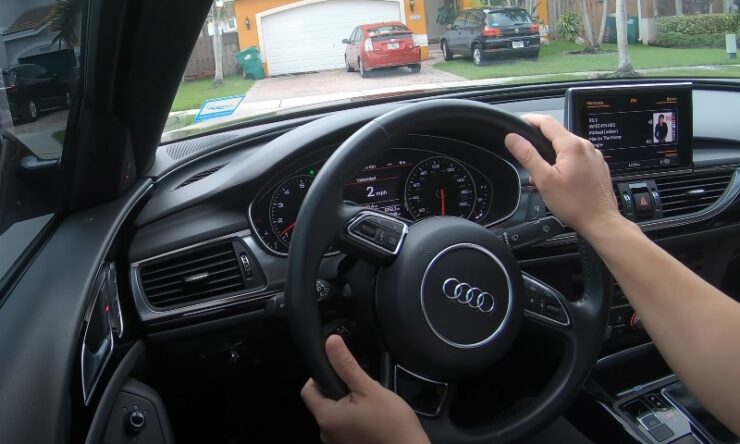When a car starts drifting to one side, driving stops feeling relaxing and starts feeling like work. You find yourself holding the wheel a little tighter, constantly correcting, and wondering if something’s wrong.
Sometimes it’s a light pull you barely notice until a long highway stretch. Other times, the car dives sharply toward the curb the moment you brake. Either way, something’s out of balance.
There’s always a cause behind that steering pull. And with a methodical approach, you can figure out what’s happening and fix it before it becomes unsafe or expensive. Let’s go step by step through what causes it, how to test things safely, and what to expect when you visit a shop.
Quick “Is It Safe to Drive?” Check
Before you start troubleshooting, you need to know whether the car should even stay on the road. A few quick checks can help you decide:
- Strong pull only while braking: Could mean a stuck brake caliper or a hydraulic issue. Safely park, then carefully feel near each wheel for one that’s much hotter. If one wheel is scorching hot, don’t keep driving. Call a shop.
- Sudden pull after hitting a pothole or curb: Probably an alignment or bent suspension issue. Drive slowly and book an inspection soon.
- Pull with vibration, thump, or wobble: Usually points to tire or wheel damage. Check pressure and tread right away. A damaged tire can blow out or make handling unpredictable.
1. Unequal Tire Pressure
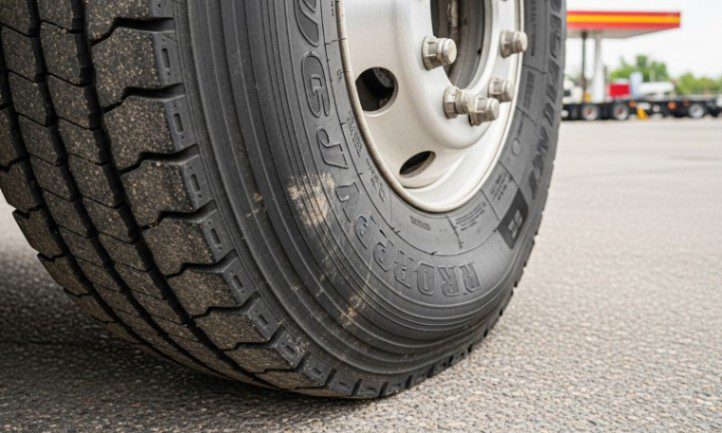
One slightly underinflated tire can steer your whole car off course. Even being a few psi off can change how a tire rolls and how the car tracks.
What to Do
- Check pressures when the tires are cold. Use a reliable gauge rather than relying solely on the dashboard light. For consistently accurate readings and durable truck-grade equipment, check out Hubtrac tires.
- Set each tire to the pressure on the driver-door sticker, not what’s printed on the tire sidewall.
- Recheck after a day. If one tire keeps losing air, have it inspected for a puncture or slow rim leak.
Why It Matters
Underinflated tires don’t just cause drift; they get hot, wear unevenly, and increase crash risk.
NHTSA data shows that tires underinflated by more than 25 percent are roughly three times more likely to be involved in a tire-related crash.
2. Wheel Alignment Out of Spec
Alignment describes the exact angles of your wheels relative to your car’s frame and the road. If those angles get knocked out of spec, the steering wheel may sit off-center, the tires wear oddly, and the car may pull constantly.
The Angles That Matter
- Camber: How much the wheels tilt in or out at the top. If one wheel leans more than the other (cross-camber), the car drifts toward that side.
- Caster: The forward or backward tilt of the steering pivot line. Differences side to side can make one wheel “lead” the other.
- Toe: Whether the wheels point slightly inward or outward. Even small errors here affect straight-line stability.
What to Do
Ask for a four-wheel alignment with a thrust-angle measurement. That ensures all four tires are working in the same direction.
After alignment, your steering wheel should be perfectly centered. Always ask for a before-and-after printout showing the values.
Good Habit
Get alignment checked:
- Once a year,
- After hitting a pothole or curb,
- Or when installing new tires.
3. Tire Conicity or Ply-Steer
View this post on Instagram
Sometimes the problem isn’t the car, it’s the tire itself. Small differences during manufacturing can cause a tire to produce a side force, making the car drift even when alignment is perfect.
How to Tell
- The car pulls on one set of tires but drives straight on another.
- Swapping the front tires left to right changes the direction or strength of the pull.
DIY Isolation
Tire Rack describes a quick test:
- Swap your front tires left to right.
- Drive on a flat, empty road.
- If the pull switches sides, the tire is the cause.
If the direction stays the same, it’s more likely alignment or suspension.
The Technical Side
SAE papers have documented tire conicity and ply-steer for decades. The short version: certain tire constructions generate small side forces, which translate into that slow, steady drift.
Fix
- If it’s a new tire , ask for a warranty replacement or road-force balancing.
- If it’s older, replace the problematic tire outright.
4. Brake Pull or Brake Drag
If the car veers when you brake, suspect the braking system. The issue might be uneven pressure or friction.
Common Causes
- A sticking caliper piston or slide pin .
- A collapsed brake hose that restricts flow to one side.
- Contaminated pads or rotors on one wheel.
What to Check
If the car pulls only during braking and drives fine otherwise, it’s probably brake-related. After a cautious drive, feel near each wheel (don’t touch hot rotors). If one side is significantly hotter, you’ve found the culprit.
Shop Diagnosis
A professional will inspect pad wear, caliper slide motion, line pressure, and hose condition. They may also test hydraulic balance between front and rear circuits.
Fix
Replace or rebuild seized calipers, change pads and rotors in axle pairs , and replace any suspect hoses. Even an aging rubber hose can collapse internally, restricting pressure and creating uneven braking.
5. Suspension or Steering Wear
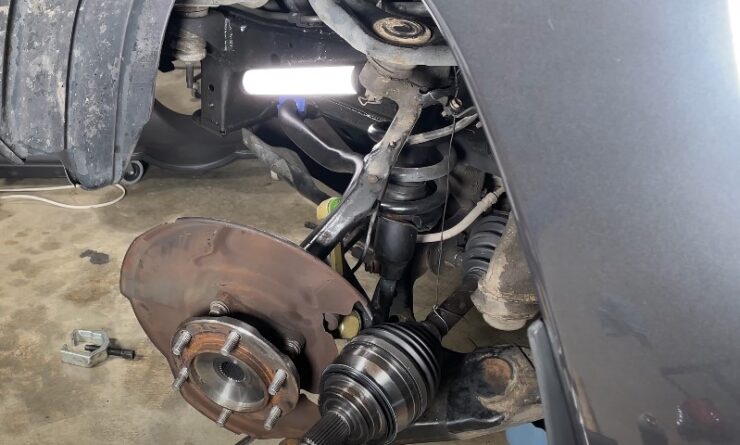
When steering components loosen up, alignment angles wander while driving. That can make the car feel inconsistent – straight one moment, pulling the next.
What to Check
Lift the front end safely and test for play:
- Grip the tire at 12 and 6 o’clock to check for ball joint or bearing looseness.
- Grip at 3 and 9 o’clock to check tie rods.
If there’s movement or clunking, schedule a suspension inspection.
Why It Matters
Worn parts don’t just cause pull. They also make stopping distances longer and can fail completely if neglected. Replacing bushings, joints, and mounts keeps the steering predictable.
6. Wheel Bearing or Hub Issues
A worn or failing front wheel bearing adds drag and can subtly steer the car. The giveaway is often a growling sound that changes with speed or direction.
What to Do
If you hear the noise and feel pull, have the hub bearings checked first. Replace the faulty bearing, then perform alignment afterward. That sequence prevents wasted adjustments.
7. Torque Steer and Drivetrain Effects
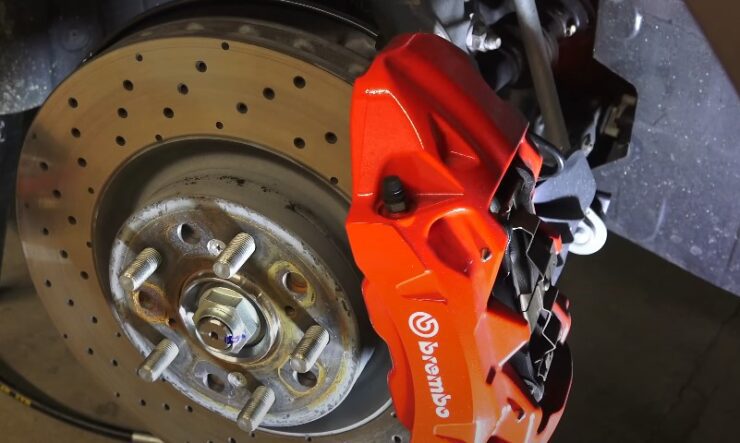
Front-wheel-drive cars, especially with powerful engines or unequal half-shaft lengths, can tug under hard acceleration. That’s torque steer.
What to Expect
- If the pull appears only under heavy throttle and disappears when cruising, it’s probably normal.
- If it’s severe or new, check for worn engine mounts, unequal tire diameters, or issues from recent drivetrain work.
8. Road Crown and “Normal” Drift
Not every drift means something’s broken. Roads are crowned slightly higher in the center for drainage, so cars naturally drift a bit toward the shoulder.
To check, drive in a flat, empty parking lot. If the car tracks straight there, the “problem” might just be the road surface.
Step-by-Step Diagnostic Flow
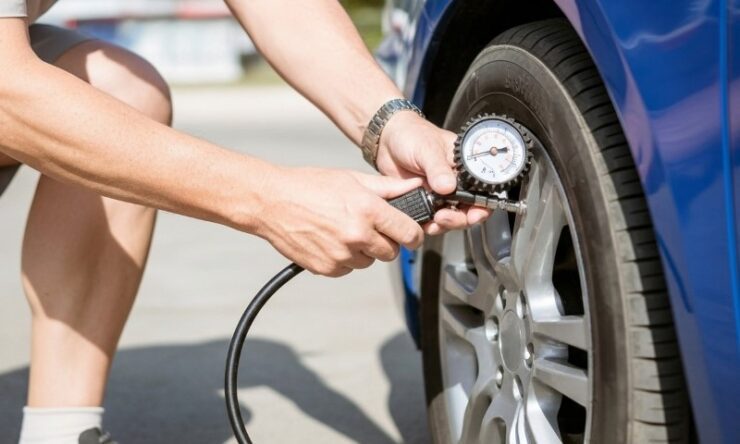
Use a safe, straight, level road. Light grip on the wheel, steady speed, and make notes.
1. Tire Basics
- Check all pressures and set them to the placard.
- Inspect tread and sidewalls for bulges or nails.
- Rotate front tires left to right and test drive.
- If the pull changes direction: it’s a tire.
- If it doesn’t: keep testing.
2. Brake Test
At about 40–50 km/h, brake gently while keeping hands light on the wheel.
- Pull only while braking = brake issue.
- Pull always = move to alignment or suspension.
3. Alignment and Suspension
If the pull persists, schedule a four-wheel alignment and have suspension components checked. Ask the shop to measure:
- Camber
- Caster
- Toe
- Thrust angle
Also request an inspection of ball joints, control arms, and bushings.
4. Advanced Checks
If the alignment is good yet the car still drifts, ask for a road-force balance or conicity test . That’s how tire shops isolate pulling tires by measuring side forces.
What to Expect from an Alignment Visit
A proper alignment isn’t just adjusting bolts. It’s a full process.
| Step | What Happens | Why It Matters |
| Pre-check | Tire pressure, wheel inspection, suspension play | Ensures correct baseline |
| Measurements | Camber, caster, toe, thrust angle | Identifies direction and severity of misalignment |
| Adjustments | To preferred targets | Reduces drift and uneven wear |
| Road test | Verify straight tracking | Confirms real-world results |
| Printout | Before/after report | Confirms job quality |
AAA recommends alignment checks at least once per year, after any major impact, or when buying new tires. Consumer Reports also notes it’s a smart way to protect your tire investment.
When It’s the Tire, Not the Car
If you’ve ruled out alignment and suspension, it may be conicity or ply-steer. Replacing parts won’t fix a tire-generated pull.
A professional shop can:
- Perform a road-force balance to measure lateral force.
- Swap tire positions in sequence to isolate the offender.
- Replace the defective tire under warranty if it’s new enough.
Physics explains why some tires push sideways slightly, but for you, the fix is simple: identify the bad tire and replace it.
Safety Reminder
Tires and brakes are safety systems, not just comfort features. NHTSA’s TireWise program stresses that correct pressure, load, and condition directly affect crash risk.
Historically, underinflated tires have been linked to thousands of crashes, injuries, and fatalities, which is why modern cars now have TPMS systems built in.
When a car starts pulling, treat it as an early warning. Addressing it quickly not only keeps your car driving straight but could prevent a serious problem later.
Common Symptoms and Likely Causes
| What You Feel | Most Likely Causes | First Steps to Try |
| Gentle drift on a flat road | Road crown, mild alignment difference, tire conicity | Check pressures, test on level surface, swap tires |
| Strong pull during braking | Stuck caliper or restricted brake hose | Stop driving hard, have brakes inspected |
| Pull with vibration or thump | Tire damage or bent wheel | Check tire for bulges, reset pressures |
| Pull after hitting a pothole | Alignment or bent control arm | Book inspection and alignment |
| Pull that changes sides after tire swap | Tire conicity | Replace or rebalance tire |
| Tug only during acceleration | Torque steer or engine mount issue | Inspect mounts and tire sizes |
What Repairs Typically Cost
| Fix Type | Estimated Cost (EUR) | Notes |
| Tire pressure correction | Free to 5 | Do it at home or at a gas station |
| Four-wheel alignment | 80–200 | Depends on region and equipment |
| Brake repair (caliper/pads/hoses) | 150–500 per axle | Includes parts and labor |
| Suspension component replacement | Variable | Requires alignment afterward |
| Tire replacement for conicity | Often covered by warranty | Ask for road-force test proof |
Always ask for a detailed estimate and a copy of your alignment report. It’s your record that geometry is correct.
Preventing Pull Before It Starts
A little routine care goes a long way toward keeping your steering straight:
- Check pressures monthly. Use placard values, not sidewall max.
- Rotate tires every 8,000–10,000 km (or per your owner’s manual).
- Avoid curbs and potholes. Impacts throw alignment off.
- Service brakes in pairs on the same axle.
- Replace aging tires early if they start tracking oddly.
Small checks like these save money and keep handling predictable.
A Realistic Example
Let’s say your car starts drifting right on the motorway. You check the pressures – they’re fine. You swap the front tires, and now the car drifts left. That’s a clear sign of tire conicity.
At the shop, alignment readings come back within spec, but the road-force test shows one front tire with excessive lateral force.
The shop replaces it under warranty. Afterward, the car drives straight again. Problem solved for almost no cost.
The Bottom Line
When your car pulls, there’s always a reason. It could be something as simple as a few psi difference in tire pressure or as serious as a failing suspension joint. Work through the basics: pressure first, brakes second, then alignment. If those check out, have the tires tested for conicity.
You’ll end up with a safer car, smoother drive, and fewer surprises the next time you hit the highway. Keeping your car tracking straight isn’t just about comfort, but about control.

